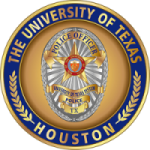Back-Up Call Center Provides Safe Distance Between Telecommunicators
July 16, 2020
Ringing phones, security surveillance, and the chatter of radio transmissions between telecommunicators, security and police officers. Those are the activities with which the Risk Operations Center (ROC) at the University of Texas Police at Houston (UT Police) are regularly abuzz.
With new COVID-19 safety recommendations in mind, Police Telecommunications Manager Loren Hebert said the ROC team has adjusted their operations in order to maintain a safe distance between staff workstations.
“We are split between our primary ROC at police headquarters and our back-up ROC located at MD Anderson's Pickens Academic Tower (FCT),” said Hebert. “The ROC employees assigned to radio dispatch assignments operate out of the back-up location, while all other ROC staff operate out of the primary site.”
The ROC serves as the main channel through which the community communicates with the police department. Calls placed to the UT Police non-emergency line at 713-792-2890 are received either in the main ROC location or at the back-up center. Calls to 9-1-1 may be answered by the Houston Emergency Center (HEC) and transferred to the UT Police ROC depending on the caller’s location.
The main ROC in headquarters, at 7777 Knight Road, is a secure room with a multi-monitor wall and six main work stations, each with three monitors. Support radios, specialized equipment and alarm alert systems aid the team in ensuring safety across MD Anderson and UTHealth. Currently, only three of the workstations at headquarters are being utilized in order to maintain safe occupational distancing during the COVID-19 pandemic.
The FCT location has served as the ROC’s emergency back-up center for many years and is equipped with radio antennae on its roof and a data center of network equipment. Having this additional location has proven instrumental during past tropical storms and other emergency events by providing a back-up location should police headquarters be adversely impacted.
Initial safety protocols calling for a minimum 6-foot distance between staff made it a logical decision to activate the back-up center to distance employees, Hebert said. The setup also meets augmented institutional safety protocols.
Since the onset of COVID, when both of our institutions decreased the number of entrances to each building to accommodate screening stations for all who enter, the ROC has seen an increased need for assistance with unlocking doors, badge access, escorts, and requests to assist hospital personnel with escorting COVID patients. The ROC also responds to requests for personal safety escorts, which are available to our community from approximately 6 p.m. to 5 a.m.
Hebert explained that on some occasions callers may be greeted with the question "Are you reporting an emergency?" This helps staff prioritize calls during peak-call periods.
“Callers should not assume they’ve called the wrong number, or if they are put on hold, that the call-taker has forgotten about them,” said Hebert. “Our call-takers all work together as a team, and someone other than the first person the caller spoke with may pick up the phone to help.”
UT Police may be reached at 713-792-2890. In the event of an emergency, dial 9-1-1.
